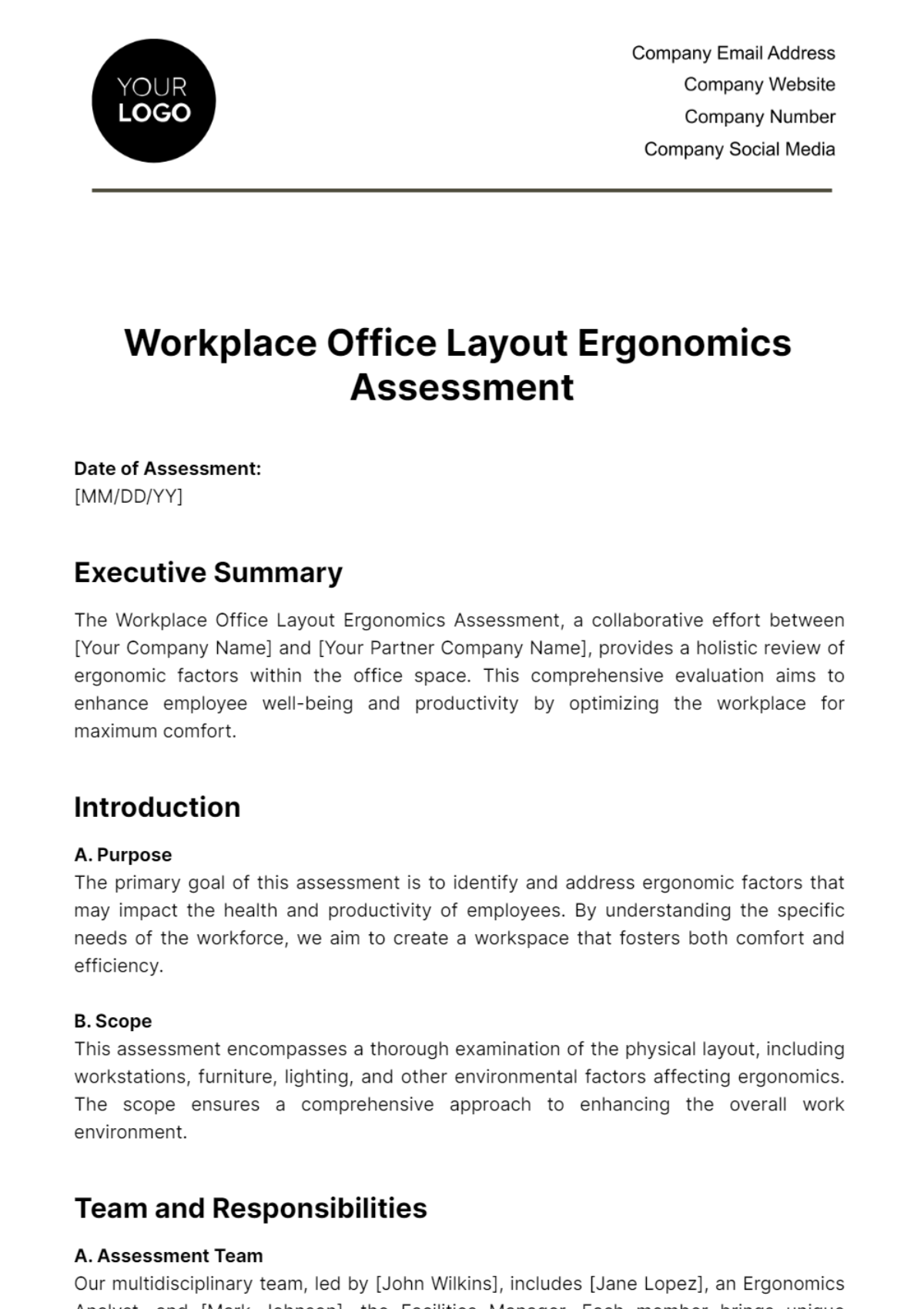Free Workplace Office Layout Ergonomics Assessment

Date of Assessment:
[MM/DD/YY]
Executive Summary
The Workplace Office Layout Ergonomics Assessment, a collaborative effort between [Your Company Name] and [Your Partner Company Name], provides a holistic review of ergonomic factors within the office space. This comprehensive evaluation aims to enhance employee well-being and productivity by optimizing the workplace for maximum comfort.
Introduction
A. Purpose
The primary goal of this assessment is to identify and address ergonomic factors that may impact the health and productivity of employees. By understanding the specific needs of the workforce, we aim to create a workspace that fosters both comfort and efficiency.
B. Scope
This assessment encompasses a thorough examination of the physical layout, including workstations, furniture, lighting, and other environmental factors affecting ergonomics. The scope ensures a comprehensive approach to enhancing the overall work environment.
Team and Responsibilities
A. Assessment Team
Our multidisciplinary team, led by [John Wilkins], includes [Jane Lopez], an Ergonomics Analyst, and [Mark Johnson], the Facilities Manager. Each member brings unique expertise to ensure a well-rounded assessment.
B. Responsibilities
[John Wilkins], as Team Lead, oversees the coordination and communication of the assessment. [Jane Lopez] conducts specific assessments and gathers data, while [Mark Johnson] provides valuable insights into facility constraints and potential changes.
Office Layout Overview
A. Floor Plan
The detailed floor plan illustrates the spatial arrangement of workstations, meeting areas, and common spaces. This visual representation is crucial for understanding the current layout and identifying areas for improvement.
B. Workstation Configuration
The workstation configuration analysis encompasses ergonomic chairs, sit-stand desks, and collaborative spaces. Our goal is to ensure that every aspect of the workspace adheres to ergonomic principles, promoting employee health and well-being.
Ergonomic Factors Assessment
A. Furniture
The assessment includes a detailed evaluation of chairs, desks, and other furniture items. Adjustable features, lumbar support, and ease of use are critical considerations. The provided table offers a systematic approach to rating and commenting on each item.
Furniture Item | Ergonomic Rating (1-5) | Comments |
Chair | 4.5 | Excellent lumbar support |
Desk | 4.7 | Adjustable height for standing |
Other Items | 4.3 | Collaborative spaces well-designed |
B. Lighting
Assessing lighting conditions involves considering both natural and artificial sources. Adequate illumination without causing glare is vital for creating a comfortable and productive work environment.
C. Temperature and Ventilation
The evaluation of temperature and ventilation focuses on creating a comfortable working environment. We aim to ensure optimal conditions that contribute to employee performance.
Employee Feedback
A. Surveys and Interviews
The collection of employee feedback through surveys and interviews provides valuable insights into individual comfort levels and ergonomic concerns. Utilizing [Your Company Name]'s social media channels ensures anonymity and encourages honest responses.
1. How would you rate the comfort of your workstation? (1-5)
-[4.6] on average
2. Do you experience any discomfort related to lighting or temperature?
-[15%] reported discomfort with lighting; [10%] reported temperature-related discomfort.
Recommendations
A. Short-Term Solutions
Immediate recommendations address urgent ergonomic issues. Timely actions, such as replacing broken chairs and adjusting lighting settings, contribute to an immediate improvement in the working environment.
Replace broken chairs by [January 31, 2051].
Adjust lighting settings by [February 15, 2051].
B. Long-Term Solutions
Proposed structural changes and long-term strategies aim to enhance overall ergonomic design. The strategic plan includes an office layout redesign and employee training on ergonomic best practices to ensure lasting improvements.
Redesign office layout by [June 30, 2051].
Implement employee training on ergonomic best practices by [July 15, 2051].
Conclusion
The key findings emphasize the importance of ongoing ergonomic considerations for employee well-being and productivity. The proposed short-term and long-term solutions seek to create a workspace that not only meets but exceeds ergonomic standards.
- 100% Customizable, free editor
- Access 1 Million+ Templates, photo’s & graphics
- Download or share as a template
- Click and replace photos, graphics, text, backgrounds
- Resize, crop, AI write & more
- Access advanced editor
Enhance workplace comfort and productivity with Template.net's Workplace Office Layout Ergonomics Assessment Template. This editable and customizable tool, powered by our Ai Editor Tool, enables you to optimize office layouts for ergonomic efficiency. Ensure a comfortable and safe environment for employees while maximizing space utilization with Template.net's innovative solutions.





























